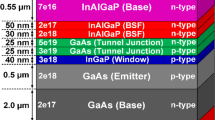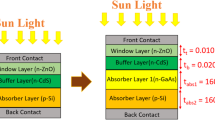Abstract
We report a numerical simulation based design and optimization of single-junction gallium antimonide (GaSb) solar cell using the two-dimensional device simulator (SILVACO-ATLAS) under AM1.5G spectrum. We considered the gallium antimonide (GaSb) material as the absorber layer because of its low band gap and silicon (Si) as the substrate layer. Previously we showed that such GaSb solar cell offers an initial conversion efficiency (η) of 29.45% after optimization. In the present work we showed that this internal efficiency can be improved further by introducing a GaSb intrinsic layer (i-layer) in between the emitter and base layer. We optimized the thickness of this low doped intrinsic layer. We show that the efficiency of the solar cell increases by introduction of such intrinsic layer and reaches a highest efficiency value of 32.09% at 300 K with an optimized intrinsic layer thickness of 60 nm. The efficiency of our designed low cost solar cell is higher than commercial silicon based solar cell and GaAs solar cell used in space application. This study shows a new family of high efficient single junction solar cells can be fabricated to harness electrical power from IR spectrum and/or heat energy.










Similar content being viewed by others
References
Andreev VM, Sorokina SV, Timoshina NK, Khvostikov VP, Shvarts MS (2009) Solar cells based on gallium antimonide. Semiconductors 43:668–671. https://doi.org/10.18052/www.scipress.com/IJET.18.1
Arzbin HR, Ghadimi A (2019) Improving the performance of a multi-junction solar cell by optimizing BSF, base and emitter layers. Mater Sci Eng 243:108–114. https://doi.org/10.1016/j.mseb.2019.04.001
Atlas User’s Manual (2018) SILVACO. In: Santa Clara, CA 95054, California, USA
Bonilla RS, Hoex B, Hamer P, Wilshaw PR (2017) Dielectric surface passivation for silicon solar cells: a review. Phys Status Solidi A 207:1–30. https://doi.org/10.1002/pssa.201700293
Bouabdelli MW, Rogti F, Maache M, Rabehi A (2020) Performance enhancement of CIGS thin-film solar cell. Optik. https://doi.org/10.1016/j.ijleo.2020.164948
Bouanani B, Joti A, Bouiadjra FS, Kadid A (2020) Band gap and thickness optimization for improvement of CIGS/CIGS tandem solar cells using Silvaco software. Optik Int J Light Electron Opt 204:164217
Dimroth F et al (2014) Wafer bonded four-junction GaInP/GaAs/GaInAsP/GaInAs concentrator solar cells with 44.7% efficiency. Prog Photovoltaics Res Appl 22:277–282. https://doi.org/10.1002/pip.2475
Fujiwara H, Kondo M (2007) Effects of a-Si: H layer thicknesses on the performance of a-Si:H/c-Si heterojunction solar cells. J Appl Phys 101:54516. https://doi.org/10.1063/1.2559975
Green M, Godfrey R, Willison M, Blakers A (1980) In: Proceedings of the 14th IEEE photovoltaic specialists conference, San Diego, vol 790, pp 684–695
Islam MJ, Mostafa S, Chowdhury MIB (2020) Thickness optimization of single junction quantum well solar cell using TCAD. Int J Eng Technol 18:1–7
Maji B, Chattopadhyay R (2019) Design and optimization of single junction GaSb solar cell for maximum utilization of IR solar spectrum. In: Optronix, 8–10th June, Kolkata
Matthew PL et al (2017) GaSb-based solar cells for full solar spectrum energy harvesting. Adv Energy Mater 7:1700345
Mostefaoui M, Mazari H, Khelifi S, Bouraiou A, Dabou R (2015) Simulation of high efficiency CIGS solar cells with SCAPS-1D software. Energy Proced 74:736–744
Peng X et al (2009) Numerical analysis of the short-circuit current density in GaInAsSb thermophotovoltaic diodes. Infrared Phys Technol 52:152–157. https://doi.org/10.1016/j.infrared.2009.06.003
Peuman P, Bulovic V, Forrest SR (2000) Efficient photon harvesting at high optical intensities in ultrathin organic double-heterostructure photovoltaic diodes. Appl Phys Lett 76:2650
Steiner M, Siefer G, Schmidt T, Wiesenfarth M, Dimroth F, Bett AW (2016) 43% Sunlight to electricity conversion efficiency using CPV. IEEE J Photovoltaics 6:1020
Tang L, Ye H, Xu J (2014) A novel zinc diffusion process for the fabrication of high-performance GaSb thermophotovoltaic cells. Sol Energy Mater Sol Cells 122:94–98. https://doi.org/10.1016/j.solmat.2013.11.027
Tinedert IE, Pezzimenti F, Megherbi ML, Saadoune A (2020) Design and simulation of a high efficiency CdS/CdTe solar cell. Optik Int J Light Electron Opt 208:164112
Van Zeghbroeck BV (2007) Principles of semiconductor devices and heterojunctions. Prentice Hall, New Jersey, p 2007
Zahari SM, Osman RM, Norizan MN, Mohamad IS, Malini A, Taking S (2015) The comparison between gallium arsenide and indium gallium arsenide as materials for solar cell performance using Silvaco application. AIP Conf Proc 1660:70047
Zhang T, Iqbal S, Zhang XY, Wu W, Dan Su, Zhou HL (2020) Recent advances in highly efficient organic-silicon hybrid solar cells. Sol Energy Mater Sol Cells 204:110245
Acknowledgements
The authors would like to acknowledge Prof. P. Chakraborty, Director, IIEST and Dept. of E&TCE, IIEST.
Author information
Authors and Affiliations
Corresponding author
Additional information
Publisher's Note
Springer Nature remains neutral with regard to jurisdictional claims in published maps and institutional affiliations.
Rights and permissions
About this article
Cite this article
Maji, B., Chattopadhyay, R. Design and optimization of high efficient GaSb homo-junction solar cell using GaSb intrinsic layer. Microsyst Technol 27, 3589–3598 (2021). https://doi.org/10.1007/s00542-020-05125-9
Received:
Accepted:
Published:
Issue Date:
DOI: https://doi.org/10.1007/s00542-020-05125-9




